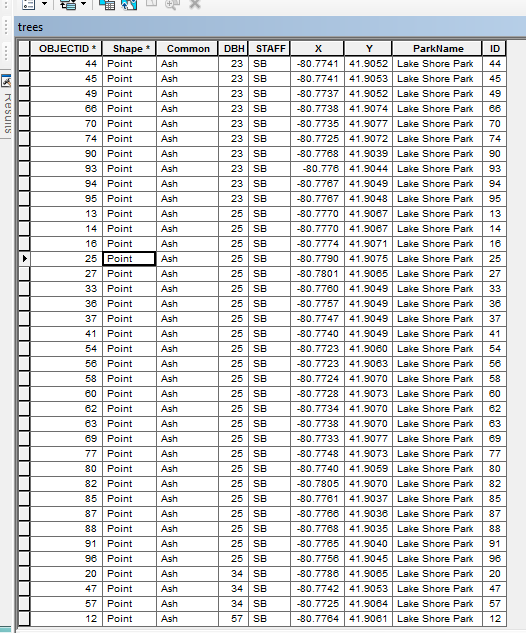- Home
- :
- All Communities
- :
- Developers
- :
- Python
- :
- Python Questions
- :
- Update Cursor Python Programming Issue
- Subscribe to RSS Feed
- Mark Topic as New
- Mark Topic as Read
- Float this Topic for Current User
- Bookmark
- Subscribe
- Mute
- Printer Friendly Page
Update Cursor Python Programming Issue
- Mark as New
- Bookmark
- Subscribe
- Mute
- Subscribe to RSS Feed
- Permalink
Hi there. I'm a frustrated student taking a programming class where I am way over my head. I am taking this class with my first GIS class (bad idea) so my understanding is very limited. That being said, if you could give clear and simple explanations, I would greatly appreciate it. Thanks!
This is the assignment question:
"For this assignment you will perform a batch update on the trees fc. While the arborists performed their tree inventory of the park, they mistakenly made some data collection errors. Each “Ash” tree that had a DBH greater than 25 should actually be an “Oak” species. Your task is to develop an update cursor/python code that performs this data fix."
This is a screenshot of my attribute table.

This one of countless attempts:

- Mark as New
- Bookmark
- Subscribe
- Mute
- Subscribe to RSS Feed
- Permalink
Your first line fails in my IDE using python 3.5
a = "C:\Temp\Unit_8_Assignment\Lake_Short_Park.gdb"
File "<ipython-input-7-23a9732c065c>", line 1
a = "C:\Temp\Unit_8_Assignment\Lake_Short_Park.gdb"
^
SyntaxError: (unicode error) 'unicodeescape' codec can't decode bytes in position 7-8: truncated \UXXXXXXXX escape
a = r"C:\Temp\Unit_8_Assignment\Lake_Short_Park.gdb" # ---- using raw formating
'C:\\Temp\\Unit_8_Assignment\\Lake_Short_Park.gdb'I didn't get beyond there since I don't have the data to test.
It looks offhand that your row[0] and cursor.update.... row have 5 spaces and not 4... check
- Mark as New
- Bookmark
- Subscribe
- Mute
- Subscribe to RSS Feed
- Permalink
Try this:
fc = r'C:\Temp\Unit8_Assignment\Lake_Shore_Park.gdb\trees'
fields = ("DBH", "Common")
with arcpy.da.UpdateCursor(fc, fields) as cursor:
for row in cursor:
if row[0] > 25 and row[1] == "Ash":
row[1] = "Oak"
cursor.updateRow(row)Your line:
if (row [0] == >25):is not valid for 2 reasons, and perhaps 3 reasons:
- the additional space after row
- the == > which should actually be just >
- if another species (no Ash) would be larger than 25 it would be changed to Oak and that might not be correct
- Mark as New
- Bookmark
- Subscribe
- Mute
- Subscribe to RSS Feed
- Permalink
your eyes are better than mine ![]() another reason I hate screen grabs of code problems
another reason I hate screen grabs of code problems
- Mark as New
- Bookmark
- Subscribe
- Mute
- Subscribe to RSS Feed
- Permalink
Thank you so much! Darn Spacing! I was thinking too that if another species was larger than 25 it would mess it up I just didn't know what to do. I didn't know I could use the 'and' . This class is online and very difficult to ask for help when I'm working on it. I thank you for taking the time to show and explain it to me. Have a great night.
- Mark as New
- Bookmark
- Subscribe
- Mute
- Subscribe to RSS Feed
- Permalink
Hi Courtney Wade , I'm glad we could help.
There is no problem to post other problems you might run in to here in GeoNet. For the next time, please use the instructions found here to copy the code into the thread: Posting code with Syntax Highlighting on GeoNet . Not only since Dan asked, but it normally helps a lot not having to type the code and being able to simply copy and paste it to see what might be wrong.
Also, it would be good if you mark the post that answered the question as the correct answer by clicking on the "Mark Correct" button:

Any post that you consider helpful can be marked as such. Just use the helpful link below the post.

- Mark as New
- Bookmark
- Subscribe
- Mute
- Subscribe to RSS Feed
- Permalink
Xander,
I was wondering if you could explain the assignment of row[0] and row[1]. How do I know that row[0] should go with "DBH" in the table? Is it based on the fact that "DBH" was listed first in your fields assignment within the python code? And is it always the case that the first row will always be assigned [0]?
- Mark as New
- Bookmark
- Subscribe
- Mute
- Subscribe to RSS Feed
- Permalink
The list of fields that you decide on using determines the slice ie row[0] means for each row using the first column... row[1] means for each row using the 2nd column. Now since you only provided two columns, and python is zero-based, the first column and second column are ('DBH', 'Common') as a tuple (round brackets) or as a list ['DBH', 'Common'] (square brackets). Remember zero-based
- Mark as New
- Bookmark
- Subscribe
- Mute
- Subscribe to RSS Feed
- Permalink
Thanks Dan! I appreciate the information you provided. It makes sense to me now.
- Mark as New
- Bookmark
- Subscribe
- Mute
- Subscribe to RSS Feed
- Permalink
Darn spacing trips me up all the time! Thank you Dan for taking the time to help me. Have a great night!